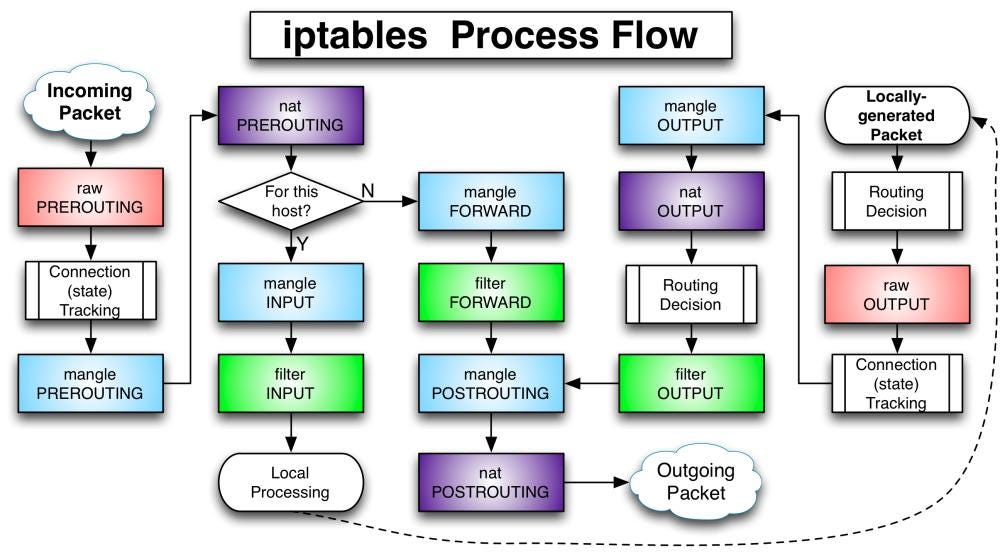Iptables is used to set up, maintain, and inspect the tables of IP packet filter rules in the Linux kernel. Several different tables may be defined. Each table contains a number of built-in chains and may also contain user-defined chains.
Each chain is a list of rules which can match a set of packets. Each rule specifies what to do with a packet that matches. This is called a ‘target’, which may be a jump to a user-defined chain in the same table.

Tables
- The filter table: This is the default and perhaps the most widely used table. It is used to make decisions about whether a packet should be allowed to reach its destination.
- The_ mangle_ table: This table allows you to alter packet headers in various ways, such as changing TTL values.
- The_ nat_ table: This table allows you to route packets to different hosts on NAT (Network Address Translation) networks by changing the source and destination addresses of packets. It is often used to allow access to services that can’t be accessed directly because they’re on a NAT network.
- The_ raw_ table: iptables is a stateful firewall, which means that packets are inspected with respect to their “state”. (For example, a packet could be part of a new connection, or it could be part of an existing connection.) The raw table allows you to work with packets before the kernel starts tracking its state. In addition, you can also exempt certain packets from the state-tracking machinery.

Chains
- The PREROUTING chain: Rules in this chain apply to packets as they just arrive on the network interface. This chain is present in the nat, mangle and raw tables.
- The INPUT chain: Rules in this chain apply to packets just before they’re given to a local process. This chain is present in the mangle and filter tables.
- The OUTPUT chain: The rules here apply to packets just after they’ve been produced by a process. This chain is present in the raw, mangle, nat and filter tables.
- The FORWARD chain: The rules here apply to any packets that are routed through the current host. This chain is only present in the mangle and filter tables.
- The POSTROUTING chain: The rules in this chain apply to packets as they just leave the network interface. This chain is present in the nat and mangle tables.
Targets
- ACCEPT: This causes iptables to accept the packet.
- DROP: iptables drops the packet. To anyone trying to connect to your system, it would appear like the system didn’t even exist.
- REJECT: iptables “rejects” the packet. It sends a “connection reset” packet in case of TCP, or a “destination host unreachable” packet in case of UDP or ICMP.
The connection tracking module – conntrack
- NEW: This state represents the very first packet of a connection.
- ESTABLISHED: This state is used for packets that are part of an existing connection.
- RELATED: This state is used for connections that are related to another _ESTABLISHED_connection.
- INVALID: This state means the packet doesn’t have a proper state. This may be due to several reasons, such as the system running out of memory or due to some types of ICMP traffic.
- UNTRACKED: Any packets exempted from connection tracking in the raw table with the NOTRACK target end up in this state.
- DNAT: This is a virtual state used to represent packets whose destination address was changed by rules in the nat table.
- SNAT: Like DNAT, this state represents packets whose source address was changed.